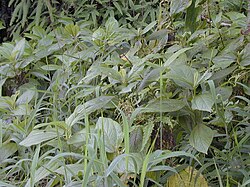| Boehmeria | |
|---|---|
 | |
| Boehmeria grandis | |
| Scientific classification | |
| Kingdom: | Plantae |
| Clade: | Tracheophytes |
| Clade: | Angiosperms |
| Clade: | Eudicots |
| Clade: | Rosids |
| Order: | Rosales |
| Family: | Urticaceae |
| Tribe: | Boehmerieae |
| Genus: | Boehmeria Jacq. |
| Type species | |
| Boehmeria ramiflora Jacq. 1760 | |
| Species | |
47 species, see text | |
| Synonyms [1] | |
| |
Boehmeria is a genus of 47 species of flowering plants in the nettle family Urticaceae. Of the species, 33 are indigenous to the Old World and 14 to the New World; no species is indigenous to both the Old and New Worlds. The species include herbaceous perennials, shrubs and small trees. Although related to the similar-looking species of the stinging nettles of genus Urtica , species of Boehmeria do not have stinging hairs. Because of the similarity in appearance, some species are commonly called "false nettles".
Contents
- Fossil record
- Cultivation and uses
- Species
- New World species
- Old World species
- Synonyms
- References
- External links
This genus is named in honour of the German botanist, Georg Rudolf Boehmer. [2]
